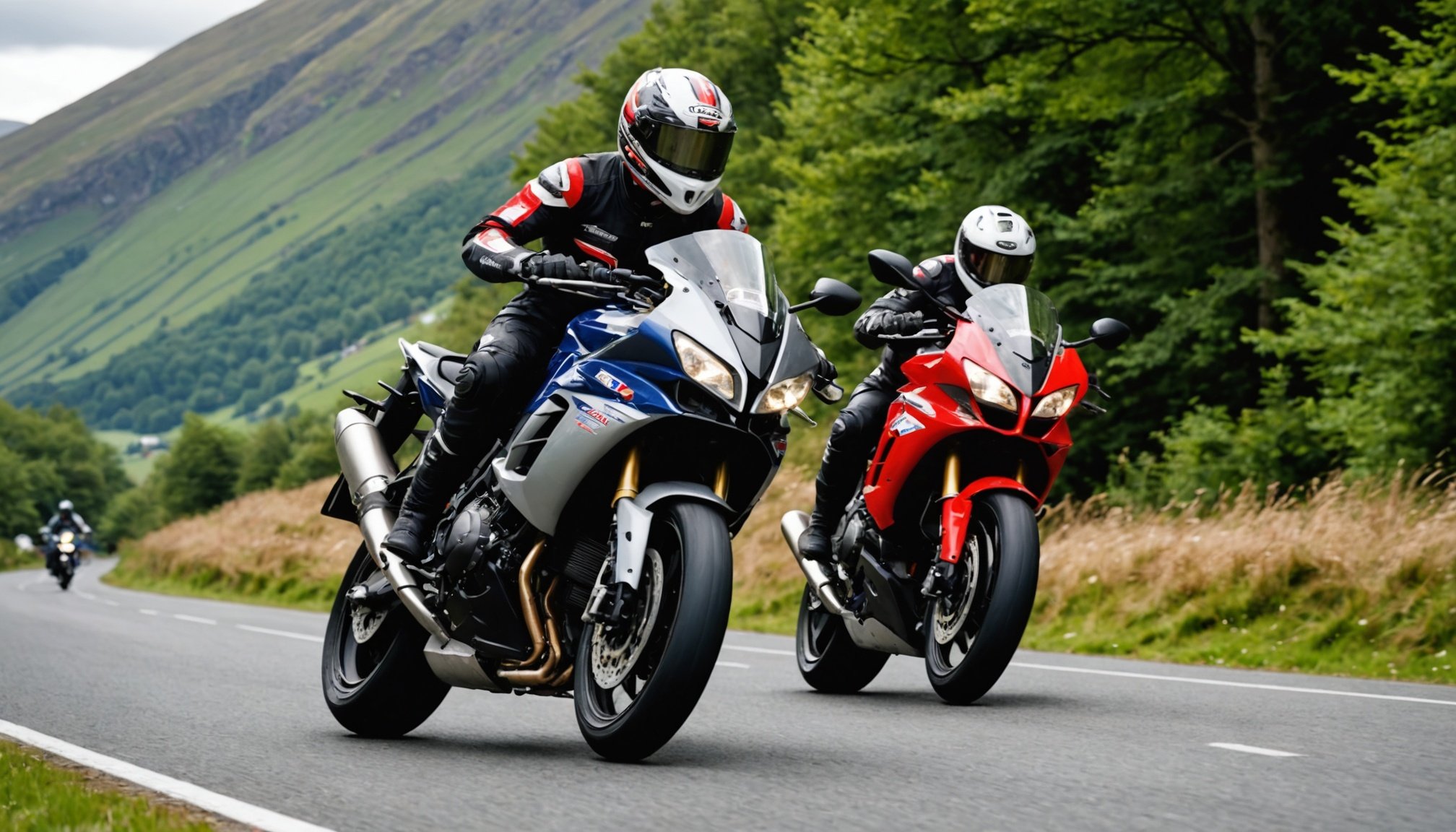Advanced Techniques for Sports Bike Handling
Mastering sports bike skills involves more than just speed; understanding balance and the center of gravity are critical, especially during competitive climbs. Positioning your body correctly can significantly affect your bike’s performance. Leaning forward slightly helps in distributing weight evenly, essential for maintaining traction and stability on steep gradients. This bike handling technique ensures that riders can manoeuvre efficiently, even when the incline becomes challenging.
To optimize traction on steep surfaces, lowering the tire pressure slightly can increase grip, allowing for smoother and more controlled ascents. Moreover, selecting the appropriate gear before climbing can prevent abrupt shifts that might disrupt balance.
This might interest you : Top Aftermarket Mirrors to Boost Visibility for UK Sport Bikes: A Comprehensive Guide
Emergency handling maneuvers are equally important. During unexpected terrain changes, quickly adjusting your weight distribution can prevent skidding. Keeping your body relaxed while maintaining a firm grip on the handlebars offers better control and responsiveness. Practice makes perfect: regularly training on diverse terrains can enhance your instinctive responses, equipping you better for sudden obstacles or changes in the environment.
Incorporating these elements into your sports bike skills repertoire not only enhances safety but also elevates your biking experience to a higher level of bike handling technique mastery.
Have you seen this : Top Tips for Securely Transporting Multiple Sport Bikes Across the UK
Competitive Strategies for Hill Climbing
To excel in hill climb performance, adopting comprehensive competitive strategies is crucial. Prioritizing the right approach can significantly enhance efficiency and results.
Timing and Pacing Techniques
Effective timing and pacing can make or break a climb. It’s essential to identify a steady rhythm tailored to the gradient and your endurance capabilities. By pacing yourself well, you conserve energy for steeper sections, maintaining a consistent speed.
Mental Preparation and Focus
Mental preparation plays a key role in successful hill climbing. Visualising success and maintaining a positive mindset can enhance focus, making challenging sections seem manageable. Concentration on breathing and form helps sustain effort over difficult terrain.
Utilizing Gear Efficiently
Leveraging your gear effectively is paramount in optimizing hill climb performance:
- Optimal Gearing Ratios: Experimenting and identifying suitable gearing ratios can help manage energy expenditure and improve efficiency on climbs.
- Cadence Role: Maintaining a consistent cadence is vital. It preserves momentum and minimizes energy loss during ascents.
- Adapt Shifting Strategies: Adjust your shifting based on the hill’s steepness, ensuring you’re in the correct gear to tackle varying inclines with ease.
Implementing these strategies collectively enhances hill climbing prowess, providing the edge needed in competitive scenarios.
Navigating Rugged UK Mountain Terrains
Embarking on adventures across UK mountain trails requires meticulous route planning and understanding of the terrain navigation challenges that lie ahead. Key among these are the renowned trails famous for their competitive hill climbs, such as the Lake District’s Helvellyn and Snowdonia’s Snowdon. These trails attract both amateurs and seasoned climbers, offering rewarding yet challenging ascents.
One crucial factor impacting terrain conditions is the unpredictable British weather, notorious for altering paths into slippery slopes and muddy hurdles. Preparing for these conditions involves scrutinising weather forecasts and understanding how varying weather patterns can affect trail viability.
Effective route planning starts with a detailed examination of maps and trail guides, crucial for familiarising oneself with the terrain specifics and potential hazards. Engaging in pre-race scouting can provide firsthand insight into the route and highlight any unforeseen obstacles, offering a strategic advantage.
To safely and skillfully conquer these formidable trails, enthusiasm must be coupled with a thoughtful approach to terrain navigation. Thus, understanding the nuances of these paths and planning all aspects of your journey is essential for an exhilarating mountain climbing experience. Whether a novice or a veteran, preparation is the key to successfully navigating these majestic yet unforgiving landscapes.
Safety Protocols during Competitive Climbs
Engaging in competitive climbing necessitates strict adherence to safety tips to ensure both personal and participant well-being. Understanding competitive climbing safety is crucial for mitigating risks associated with this high-demand sport.
Essential Safety Gear
The use of appropriate safety gear cannot be overstated. Climbers should equip themselves with helmets, harnesses, and high-quality crash pads to soften potential falls. Regular maintenance and checks on this gear are pivotal as wear and tear can diminish effectiveness over time. Footwear should suit the specific climbing environment and provide enough grip and support.
Risk Assessment and Mitigation
Conducting a thorough risk assessment is paramount. Identifying potential hazards such as slippery surfaces or unstable holds should precede every climb. A personal safety checklist aids in ensuring all measures are in place before any ascent. This may include checks on weather conditions, gear functionality, and physical readiness.
Emergency Procedures Post-Crash
Reacting swiftly and effectively to accidents can prevent further injury. Understanding common hazards in hill climbing, like sudden weather shifts or losing grip on holds, allows climbers to anticipate difficulties. Post-crash, contacting event officials and receiving on-site first aid should be immediate priorities. Knowing these emergency procedures helps climbers remain prepared and assured.
Insights from Expert Riders
In the realm of UK mountain racing, expert analysis is invaluable. Seasoned competitors, drawing on years of experience, share unique insights into what it takes to excel. These insights are not only enlightening for novices but also beneficial for riders seeking to refine their skills and strategies.
In interviews, many seasoned competitors highlight the importance of personal experiences in shaping their racing style. Lessons learned on the rugged trails of the UK mountains teach resilience, adaptability, and the ability to perform under pressure. What is most compelling is the emphasis on practical learning through real-world challenges – a theory reinforced time and again through trails that test both mental and physical endurance.
A recurring theme in these discussions is the value of mentorship and community support. Many riders attribute significant aspects of their success to mentors who provide guidance and share valuable knowledge. This community offers a supportive network where skills can be honed, and personal experiences discussed openly. It demonstrates trust and camaraderie that enrich the riding experience.
Thus, combining personal experiences, seasoned guidance, and community support presents a holistic approach to mastering competitive mountain racing, ultimately leading to improved performance and satisfaction on the trails.











